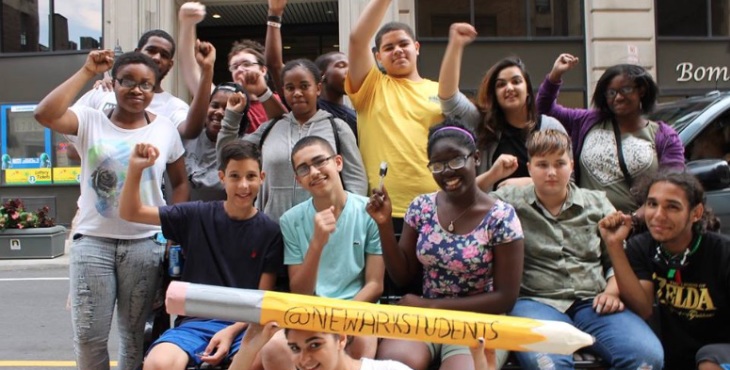By Sarah Lahm.
In the past year, from Baltimore to Philadelphia, Newark to Chicago, and California to Colorado, high school students have led the way in carrying out protests–about the intersection of education, injustice, racism, and power. This active organizing has built a foundation that could make this year a turning point, and make 2015 the Year of the Student.
On December 15 in Oakland, California, high school students walked out to protest the Michael Brown and Eric Garner cases, and rallied in front of the Fruitvale BART station where Oscar Grant III was killed by police in 2009. When interviewed by a local CBS affiliate, these students drew connections between the criminalization of black men and the conditions they have experienced in their public schools. According to protest organizer Yvette Felarca. the students want “…justice for Michael Brown and Eric Garner,” as well as an end not only to the “Jim Crow justice system,” but also to segregated schools and unequal educational opportunities.
Then, on December 18, in Baltimore, Maryland, a group of high school students took over a school board meeting, chanting, “Black Lives Matter.” The students are part of a group called the Baltimore Algebra Project (their website tagline is striking: “No Education, No Life”), and they were protesting the proposed closure of six Baltimore schools. Wearing “I Can’t Breathe” t-shirts, the students pushed out the school board members, took over their chairs, and listened to testimony about why one of the schools in particular–Baltimore’s Heritage High School–should not be closed.
The Baltimore school board ultimately resumed their meeting and voted to close Heritage High and four of the other schools on their list. This may not be the final word on the matter, however, as the BAP’s website lists saving Heritage High as one of their key organizing projects, saying, “The BAP has had a tutoring site and classroom cohort at the school for several years and is working to ensure that the people closest to the school get to decide what happens to the school.”
Earlier in 2014, in September, hundreds of Colorado high school students walked out of their schools, in protest of a proposed whitewash–literally–of their AP History textbooks. The Jefferson County Board of Education argued that instructional materials given to students should prop up the United States as a golden land of opportunity and freedom for all: “Materials should promote citizenship, patriotism, essentials and benefits of the free enterprise system, respect for authority and respect for individual rights.”
Thankfully, students and teachers in Jefferson County Colorado weren’t drinking the Kool-Aide (initially sold as a way to promote more “transparency and accountability” in classrooms) and took to the streets in protest. An October Washington Post article about this notes that the protests have worked, sort of, as the school board eventually agreed to let students and parents weigh in on the curriculum review, “though it didn’t promise to listen.”
The Philadelphia Students Union (PSU) have also been incredible activists this year, as they have not only organized mightily against school closures and the actions of their government-appointed school “reform” committee (which takes the place of a democratically-elected school board), but have also drawn clear connections between educational injustice and police brutality and violence.
In a statement on the PSU website, the group links our nation’s corrupt justice system with public education, saying, “We know that the justice system in the United States is criminally broken, serving the few and incarcerating many for minor offenses….This system does not rehabilitate, it destroys Black lives and breaks apart black families. Our education system, too, is broken and violent.”
And then there is Newark, the site of one of the most blatant and inept takeovers of a public school system. The city, however, is not going down without a fight, thanks to the actions of the Newark Students Union, which has been especially vocal and active about exposing the push for privatization and profiteering happening at their expense. From leading a protest against an ill-conceived “One Newark” makeover of their schools to a November bus trip to Washington D.C., which disrupted Newark superintendent Cami Anderson’s scheduled appearance at the conversative American Enterprise Institute, these students are living examples of democracy in action–and not the kind of feel-good, apple pie democracy that a conservative school board would find acceptable.
Instead, as one of their leaders, Kristin Towkaniuk put it, “We are building a movement to take back democratic local control of our schools.”
To Towkaniuk and all of the student leaders who stood up in 2014, we are here to follow your lead, and make 2015 the Year of the Student.
Sarah Lahm is a Minneapolis-based writer and public school parent. She was an English Instructor for over ten years, and has also worked for Head Start as a Family Literacy Specialist.






The War Report on Public Education
This is the year of the Student. I agree. Nice piece.
Christine Langhoff
What all of us who teach them know: The kids are alright!